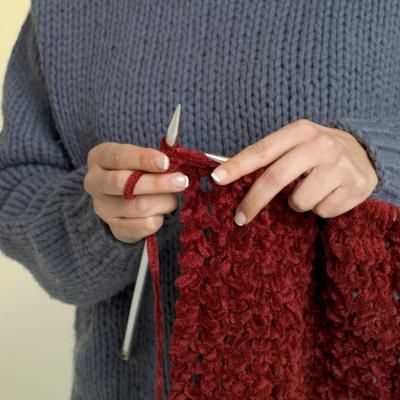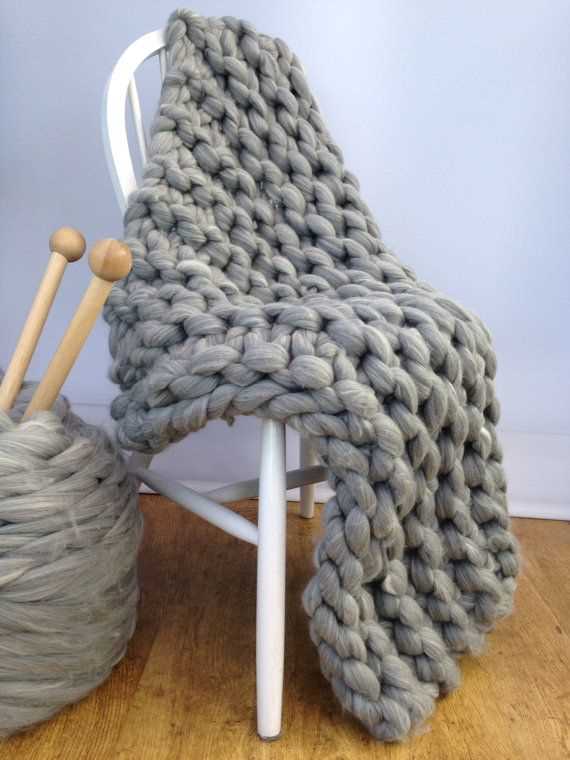Are you ready to take your knitting skills to the next level? Knitting a blanket with circular needles is a great project for intermediate knitters looking to expand their repertoire. Not only is it a functional and cozy addition to any home, but it also allows you to experiment with different stitch patterns and color combinations.
In this step-by-step guide, we will walk you through the process of knitting a blanket using circular needles. Whether you’re a seasoned knitter or a beginner looking for a new challenge, this guide will provide you with the knowledge and techniques you need to successfully complete this project.
First, we’ll start by explaining what circular needles are and why they are the preferred tool for knitting large, flat projects like blankets. We’ll also discuss the different types of circular needles available and how to choose the right size and material for your project. Once you have your needles, we’ll guide you through casting on, joining in the round, and working the body of the blanket.
Throughout the guide, we’ll include helpful tips and tricks to make the process easier and more enjoyable. We’ll also provide instructions for basic stitch patterns and how to incorporate different colors and textures into your blanket. By the end, you’ll have a beautiful and unique blanket that you can proudly display or gift to a loved one.
Choose the Right Yarn
When knitting a blanket with circular needles, it’s important to choose the right yarn for the project. The type of yarn you select will determine the final look, feel, and durability of your blanket.
Consider the following factors when choosing yarn for your project:
- Fiber content: Yarn can be made from a variety of fibers such as wool, acrylic, cotton, or a blend. Each fiber has its own characteristics, so consider factors like breathability, warmth, and ease of care when selecting the fiber content.
- Weight: Yarn comes in different weights, ranging from lace weight (very fine) to super bulky (very thick). The weight of the yarn will determine the size and weight of your finished blanket.
- Color: Choose a color that matches your personal taste and the desired aesthetic of your blanket. Consider the overall color scheme and any patterns or designs you plan to incorporate.
- Texture: Yarn can have different textures, such as smooth, fuzzy, or nubby. Consider how the texture will enhance or complement the design of your blanket.
- Quantity: Calculate the amount of yarn you will need based on the size of your blanket and the chosen pattern. Make sure to buy enough yarn to complete the project, accounting for any additional yarn needed for borders or edging.
It’s also a good idea to read reviews or ask for recommendations from fellow knitters to get an idea of how a specific yarn performs for blankets. Take the time to touch and feel the yarn before making a final decision to ensure it meets your expectations.
By carefully considering these factors, you’ll be able to choose the right yarn that will result in a beautiful and functional knitted blanket.
Select the Correct Needle Size
Choosing the right needle size is essential for creating a well-balanced and properly tensioned knit blanket. The needle size will determine the overall size of your stitches and how tight or loose your fabric will be.
When selecting your needle size, consider the following:
- Yarn Weight: Different yarn weights require different needle sizes. Check the yarn label for recommended needle size ranges.
- Gauge: Take time to create a gauge swatch before starting your blanket. This will help you determine if you need to adjust your needle size to achieve the desired gauge.
- Personal Preference: Some knitters prefer a tighter or looser tension, so experiment with different needle sizes to find the one that gives you the desired result.
Once you have considered these factors, choose a circular needle size that is appropriate for your yarn and desired finished appearance. Circular needles are a great choice for knitting a blanket, as they allow you to easily accommodate a large number of stitches.
Remember to check the needle size recommended in your pattern, as some patterns may specify a particular size to achieve the desired outcome. It’s always a good idea to create a test swatch before starting your project to ensure that the needle size you have chosen will produce the desired results.
Cast On Stitches
Before you can start knitting your blanket, you’ll need to cast on stitches onto your circular needles. Casting on is the process of creating the first row of stitches. Here’s how you can do it:
- Hold the Needle: Hold one circular needle in your right hand and the other needle in your left hand. Make sure the needle tips are pointing away from you.
- Make a Slip Knot: Take the end of your yarn and make a small loop. Pull the end of the yarn through the loop to create a slip knot. Place the slip knot onto your right-hand needle, leaving a tail of yarn about 6 inches long.
- Hold the Needles: With your right hand, hold the needle with the slip knot, and with your left hand, hold the other needle. Make sure the slip knot is snug on the needle.
- Cross the Needles: Cross the needles so that the right-hand needle is on top of the left-hand needle.
- Insert the Needle: With your right-hand needle, insert it into the loop on the left-hand needle, going from front to back.
- Wrap Yarn: Take the working yarn with your right hand and wrap it around the right-hand needle in a counterclockwise direction.
- Pull Through: Using your right-hand needle, pull the loop of yarn through the loop on the left-hand needle, creating a new stitch on the right-hand needle.
- Repeat: Continue steps 5-7 until you have cast on the required number of stitches for your blanket.
Once you’ve cast on all the stitches, you’re ready to start knitting your blanket!
Start Knitting the Border
Now that you have cast on your stitches and completed the main body of the blanket, it’s time to start knitting the border. The border will help give your blanket a finished look and provide stability to the edges.
Materials:
- Circular knitting needles
- Yarn in the color of your choice
- Tapestry needle
- Scissors
Step 1: Choose your stitch pattern
There are many different stitch patterns you can use for your border. You can choose a simple garter stitch, a ribbed pattern, or even a more intricate lace pattern. Think about the overall look you want for your blanket and choose a stitch pattern that complements it.
Step 2: Determine the size of your border
Decide how wide you want your border to be. This will depend on your personal preference and the size of your blanket. A typical border is usually around 2-4 inches wide.
Step 3: Begin knitting the border
- Start by picking up stitches along one edge of your blanket. Insert your needle into the first stitch and wrap the yarn around the needle, pulling it through to create a new stitch.
- Continue picking up stitches along the entire edge, spacing them evenly apart. The number of stitches you pick up will depend on the size of your blanket and the width of your border.
- Once you have picked up all the stitches along one edge, knit each stitch across. Repeat this process for each remaining edge of your blanket.
Step 4: Continue knitting the border
After completing the first row of your border, continue knitting in your chosen stitch pattern for the desired width. You can use stitch markers to help keep track of your progress and ensure a consistent border.
Step 5: Bind off and finish
Once you have reached the desired width for your border, bind off all stitches. Cut the yarn, leaving a tail for weaving in later. Use a tapestry needle to weave in any loose ends, and your blanket with a border is complete!
Adding a border to your knitted blanket can elevate the overall look and provide a professional finish. Experiment with different stitch patterns and sizes to find the perfect border for your project.
Knit the Middle Section
The middle section of the blanket is where you will create the bulk of the fabric. This is the part of the blanket that will keep you warm and cozy.
- Begin by knitting each round in the stitch pattern of your choice. You can use a simple knit stitch or experiment with more intricate stitch patterns.
- Continue knitting in rounds until the middle section of the blanket reaches your desired length. This will depend on how large you want the finished blanket to be.
- Make sure to periodically measure the blanket to ensure it is the correct length. You can do this by laying the blanket flat and measuring from one edge to the other.
- As you knit, be sure to keep track of the number of rows or rounds you have completed so that you can maintain consistency throughout the blanket.
- Remember to take breaks and stretch your hands and fingers to prevent fatigue or strain.
If you want to add some visual interest to the middle section of the blanket, you can try adding color changes, stripes, or even a simple pattern such as a seed stitch or garter stitch.
Once the middle section is complete, you can move on to knitting the border of the blanket.
Change Colors and Create a Pattern
Changing colors in your knitting project can add a touch of creativity and design. You can create unique patterns and color combinations to make your blanket more interesting and personalized. Here are some tips on how to change colors and create a pattern while knitting with circular needles.
1. Choose your color palette: Before you start knitting, decide on the colors you want to use for your pattern. You can choose contrasting colors for a bold look or go for a more subtle gradient effect with shades of the same color.
2. Plan your pattern: Decide on the pattern you want to create on your blanket. You can choose a simple striped pattern or opt for more complex patterns like polka dots or chevrons. Use graph paper to sketch out your pattern and plan the placement of each color.
3. Carry the yarn: When changing colors, you’ll need to carry the yarn along the side of your work. To do this, simply drop the old color and pick up the new color, leaving a tail of about 6 inches. As you knit, twist the two yarns together every few stitches to secure them.
4. Weave in the ends: After changing colors, you’ll have loose ends of yarn hanging at the sides of your blanket. To tidy up your work, weave in these ends using a tapestry needle. Thread the loose end through the needle, and then weave it back and forth through the stitches on the wrong side of your work, securing it in place.
5. Use stitch markers: If you have a complex pattern, use stitch markers to help you keep track of where to change colors. Place a marker before the stitch where you want to change colors and then knit until you reach the marker. This will help you maintain the consistency of your pattern.
6. Experiment with different techniques: There are various techniques you can try to create different color patterns. Some popular techniques include stranded knitting, intarsia, and slip stitch. Research these techniques and try them out to create unique patterns on your blanket.
7. Have fun: Knitting is a creative and enjoyable craft, so don’t be afraid to experiment and have fun with your color choices and patterns. Let your imagination guide you and create a blanket that reflects your personal style.
By following these tips, you can easily change colors and create a beautiful pattern as you knit your blanket with circular needles. Enjoy the process and watch your project come to life!
Knit the Final Rows
Once you have reached the desired length for your blanket, it’s time to knit the final rows to finish it off.
Step 1: Knit the next row as usual, following the established stitch pattern.
Step 2: Continue knitting each row in the established stitch pattern until you reach the last row.
Step 3: On the last row, make sure to create a neat and even edge. You can do this by knitting the last stitch using a different technique or by using a specific stitch pattern for the edge.
Step 4: Bind off the stitches to secure the edges of your blanket. You can use a regular bind off method or choose a decorative bind off if desired.
Step 5: Cut the yarn, leaving a tail that is long enough to weave in later.
Step 6: Weave in the yarn tail using a tapestry needle to hide it and secure it in place.
Step 7: Gently block your blanket to even out any irregularities and give it a polished look. You can do this by dampening the blanket with water or using steam, then carefully stretching it to the desired shape and laying it flat to dry.
And there you have it! Your blanket is now complete and ready to be enjoyed.
Bind Off and Finish the Blanket
Once you have completed the desired length for your blanket, it’s time to bind off the stitches and finish the edges.
- Begin by knitting the first two stitches of the row.
- Insert the left needle into the first stitch on the right needle.
- Lift the first stitch over the second stitch and off the right needle.
- Knit the next stitch on the left needle.
- Repeat steps 2-4 until you have bound off all the stitches except the last one.
- Cut the yarn, leaving a long tail.
- Pull the tail through the last stitch and tighten to secure.
With the stitches bound off, you can now finish the edges of the blanket. There are several options to choose from:
- Single Crochet Edging: With a crochet hook, single crochet around the entire edge of the blanket. This will create a neat and finished look.
- Picot Edging: With a crochet hook, create a picot edge by chaining 3, then slip stitching into the first chain. Repeat around the entire edge of the blanket.
- I-Cord Edging: With double-pointed needles, pick up stitches along the edge of the blanket. Knit an I-cord by knitting all stitches until it reaches your desired length. Bind off and sew the I-cord to the edge of the blanket.
- Lace Edging: With a crochet hook or knitting needles, work a lace pattern along the edge of the blanket. This can add a delicate and decorative touch.
Once you have finished the edge of the blanket, weave in any loose ends and give your blanket a gentle block if desired. Now your beautiful knitted blanket is complete and ready to be enjoyed!
FAQ:
What materials do I need to knit a blanket with circular needles?
To knit a blanket with circular needles, you will need a pair of circular knitting needles (size will depend on the desired thickness of the blanket), a tape measure, stitch markers, and yarn of your choice.
Can I use circular needles to knit a blanket in any size?
Yes, circular needles can be used to knit a blanket in any size. The length of the circular needles should be chosen based on the width of the blanket you want to knit.
How do I cast on stitches for knitting a blanket with circular needles?
To cast on stitches for knitting a blanket with circular needles, start by making a slipknot and placing it on one of the needles. Then, insert the other needle into the slipknot and wrap the yarn around it. Pull the loop through the slipknot to create a new stitch. Repeat this process until you have cast on the desired number of stitches.
What is the best stitch pattern to use for knitting a blanket with circular needles?
The best stitch pattern to use for knitting a blanket with circular needles depends on personal preference. Some popular stitch patterns for blankets include garter stitch, stockinette stitch, and seed stitch. You can also get creative and incorporate different stitch patterns or textures.
How do I join a new ball of yarn when knitting a blanket with circular needles?
To join a new ball of yarn when knitting a blanket with circular needles, first, make sure the old ball of yarn has reached the end of the row. Leave a tail of about 6 inches. Take the new ball of yarn, leaving a tail of about 6 inches as well, and tie a knot around the old yarn tail. Continue knitting with the new ball of yarn.
How do I bind off stitches when knitting a blanket with circular needles?
To bind off stitches when knitting a blanket with circular needles, start by knitting two stitches. Then, use the left needle to lift the first stitch over the second stitch and off the right needle. Knit one more stitch, and repeat the process of lifting the previous stitch over the new stitch until you have bound off all the stitches. Cut the yarn, leaving a tail of about 6 inches, and pull it through the last loop to secure the bind off.


